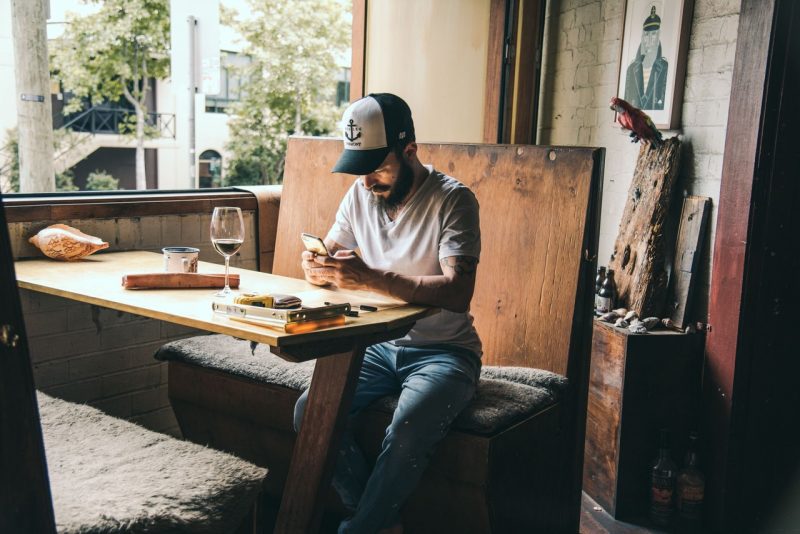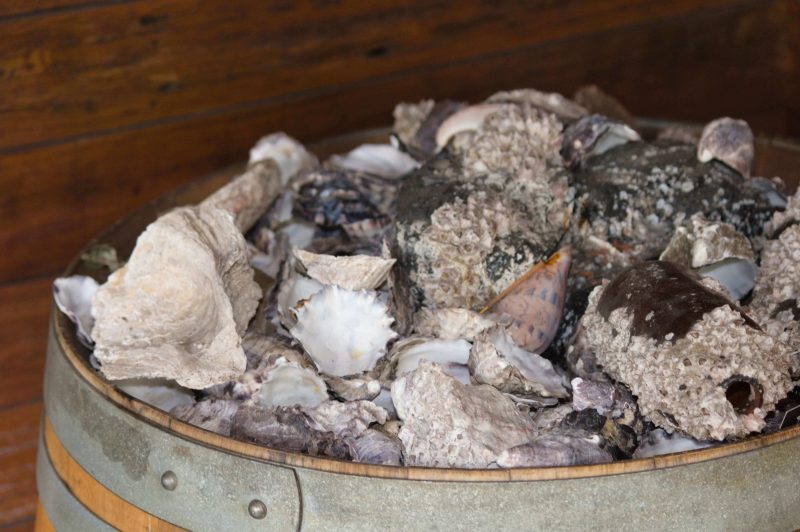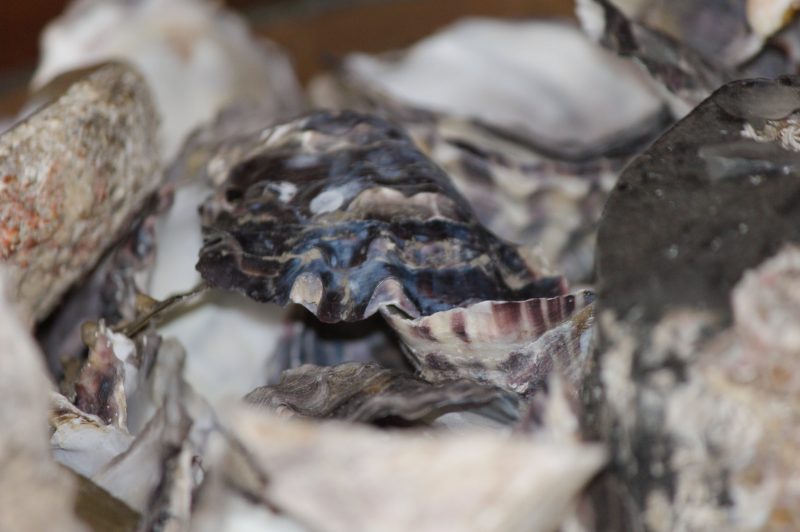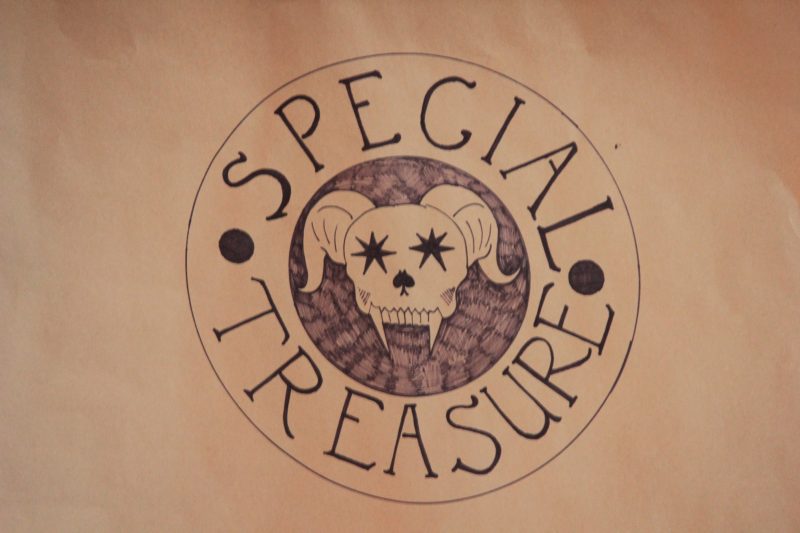Pegleg, Sydney’s Colonial Rum, and Gin Bar
Podcast: Play in new window | Download
Subscribe: Apple Podcasts | RSS
[00:40] Hi, it’s Cullen here from EATT Magazine. I’m here in Sydney’s Colonial Rum and Gin Bar, Peg leg Pyrmont which I have recently stumbled across. I’m next to Collin Perillo.
Thanks, Collin for joining us. Now, can I just ask you, how did you come up with this nautically inspired space?

I mean to me, it’s not tiki, it’s much more than that. I felt like I was stepping on board a ship. I thought like I was arriving somewhere, like stepping into another reality.

[01:19] Wow. Well, that’s a brilliant description Cullen because you’ve put it in more eloquent words than what we set to achieve. I’m happy that you used the word Tiki there because Manuel and I do come from a Tiki bartending background which we were both quite passionate about.
But with Pegleg, we chose to do something a little bit different, whereas Tiki was mostly inspired by the postwar experience of most Americans who were in the South Pacific, who brought back a little bit of South Pacific Polynesian Culture and then Americanized the hell out of it by making it fluorescent colors and templated all over California and Hawaii.
What we chose to do with this building, when we found out what it was and what its historical value was to Australian booze culture, what we decided to do was come up with our own version of Tiki, which we affectionately called Oz Tiki.
[02:18] That’s fundamentally how Pegleg begins. When Manuel and I, got the lease for this building. We found out that it was the oldest pub in Pyrmont. A 159-year-old pub in a country that’s a little over 200 years old with Europeans buildings over here.
When we started looking at that, we did a little bit of math, and we figured out Captain Cook had arrived 80 years before this building and the first fleet’s had started arriving in this island, 50 years before this building was constructed.
Then we started looking into a little bit of Australian history, we knew from there and started thinking about, okay, so what do we know about Pyrmont?
Well, what was Pyrmont in the earliest days?
This peninsula, surprisingly was the quarry where the convicts that we all learned about in our history books were sent to cut rocks, to build the suburb in the CBD of Sydney, which is famously called The Rocks. Well, those rocks came from the sandstone that’s just below us and one of the longest roads, probably, the first road longer than two miles built on this island by Europeans would have been the road going from the rocks to the quarry.
And that would be to carry the rocks to build the stone roads from here

Oyster shells among the bottles add to the unique look and feel of the Pegleg bar
[03:48] Exactly.
And so when we, when we found that out, that was the little starting point of this suburb and where it comes from and we started thinking of ourselves, so what would this pub have been like when, it was brand new, and we looked around, and we said, well, it’s a very British looking pub to my and Manuel’s eyes, both of us having lived in London.
We also trained in London for the better part of a decade and then moved to Australia to try our hand at opening bars here.
We looked at this beautiful old English pub as we recognised it and went, oh, this place, sure looks like it was built by a bunch of Englishman and Irishman who probably just arrived here from over there and built what they were familiar with back home. Well, we love English pubs and Irish pubs.
[04:35] We decided to roll with that. But instead of making an English or an Irish pub, which is a little bit contrived in my opinion, we decided to do something unapologetically Australian because as foreigners living in London, but loving all that cool British stuff that they have in London, like fish and chips, meat pies, you know, Sunday roast, all that kind of stuff.
Both of us having arrived in Australia found that Aussies find those things to be very heritage Australian foods and dishes and part of our culture here as well, but just quietly between you and me, because we have better ingredients and a lot of other good things going for us in this country, I found that we do a lot of those things, a heck of a lot better here in Australia than we do than we did in the UK.
Manuel and I decided to take all of that completely onboard and do all of these heritage focused foods, meat pies, Sunday roasts, fish and chips, fresh oysters, and then keep going further and further down the pathway of what makes Australia, unique and awesome.
Well, we have some of the best seafood in the world in this country. Also, just a stone’s throw down the hill from our location here in Pyrmont is one of the greatest seafood markets in the world and one of the best ones in our continent, the Sydney Seafood Market.
And is it true you get your seafood delivered fresh from only a few meters away?

[06:04] Mostly true, if we include in the delivery process, the fact that our head chef does the carrying of the delivery.
Our head chef, whose name is John, who’s an absolute legend, walks down that hill at the beginning of his shift and picks out what fish he wants and the oysters he is going to be serving that day.
Everything is virtually as fresh as it could be lest we fished at ourselves. And I don’t like waking up early in the morning, so I’m not fishing.
But on the other hand, John does a great job picking out amazing products and one of the things we decided to do, is focus on things that we in this city have that makes it a great place. You know, not everybody in the world is lucky enough to have amazing seafood dropped off within walking distance in the middle of a major city where we can also have great chefs like John, cook it up for us.
[07:02] Manuel and I were very inspired by some Cornish friends, friends from Cornwall in Britain who took a lot of pride in their British heritage food and a lot of their connection to the food was the fact that they often knew the fishermen who caught the fish and their local pub and a local brewer would be making the real ale that they would both be drinking and battering their fish and chips with.
And so what we started thinking about was the finest quality of those foods, and what they often are.
It often comes down to the quality and ingredients, and we have access to the best ingredients in the world here. So if we use them and we get the temperatures right, and we work with really passionate and competent chefs who can get all those kind of details right, we can’t produce bad food. We have to get some of the best quality versions of these dishes that we all love coming out of our bar and a restaurant.
[07:59] Yeah and I noticed that there’s a very Australian feel to have a good Australian beer menu.
You’ve also got a good selection of Australian wines, is that true
[08:17] That’s a great observation. We tried to focus on showing off what is great that we make on in this country and we also have a lot of love for New Zealand.
[08:31] Yeah, let’s talk about New Zealand though, because I think I’ve got some on my hand right now and it’s extraordinary rum.
[08:38] So when we first met, and you happened to notice that we have a very strong rum showing, that’s for a bunch of reasons. One of the reasons is that, as you may know, the first currency in this country was actually rum.
There’s a little bit of fun history connected with Pyrmont. The Peninsula Pyrmont at one point in early Australian history before we adopted the pound, the peninsula itself was purchased for a gallon of rum, as the story goes, there’s actually a pub down the street called Gallon in honor of that story.
And we joke every time we pay a bill with someone that we accept, both of Australian currencies, the Australian dollar and Rum.
[09:27] Also, I know that you know that you’ve got some great cocktails here and I guess my sense is, before I walked in here, the whole entrance way through the window, I feel like I am much closer to the ocean than I am.
[10:01] Well, thanks very much for noticing that. When we looked at the history of this neighbourhood and the building itself, we found out that Darling harbour was effectively what Ellis Island is to Americans, but for European immigrants who came to Australia and specifically New South Wales.
[10:21] Do you want to explain to our listeners who might not know what Ellis Island is?
[10:28] Gladly. So Ellis island is the island in New York, near Manhattan, where most European immigrants for a period of early European immigration to North America would have come via Ellis island because that’s where immigration was controlled.
That’s where they were processed, right?
[10:45] Exactly. And here in Darling Harbor, we have something called the welcome wall because that’s, which is just immediately next to the National Maritime Museum and this is in commemoration of the fact that that was our immigration point for Europeans coming to New South Wales. So we wanted to learn everything we could and then as we came up with this fun new idea, which is Oz Tiki, we kept going and going with it because it’s actually quite relevant to this neighborhood and the building.
So, the Ellis Island of Australia, the immigration port, which is Darling Harbor for well over 100 years is literally 100 meters from here. This being the oldest pub in Pyrmont, what we came to realize is that many of the very first European immigrants to this island might’ve gotten off that boat, sign their papers, and then thought to themselves, I’ve just been on a boat for three months at sea. I can do with a beer.

[12:06] And we would have been the nearest pub to that port. Now there are pubs older than us, in the rocks. The rocks are two miles, hike up a hill, just trying to put myself in the shoes of somebody who just got off a boat three months at sea.
I’d be looking for the nearest pub with the coldest beer. So part of the fun part of this concept that we came up with is a lot of our friends whose ancestors have been here longer, more generations than ours, their ancestors might have had their first beer on this island in our bar.
For us, that’s quite a unique part of Australian culture and booze history. We wanted to make that into a good thing. I don’t see alcohol and drinking culture in this country as being a demon to be avoided. I think that it’s actually how we socialize, how we get to know each other, how we party, how we celebrate, how we date, how we court, how we do a lot of the best things that lead to other great things in our lives and so our goal is to create an environment where people can do that and enjoy it, and it’s a positive thing
Brilliant. I guess for me coming back to Sydney, I always strongly felt a real sense of history here in a way, even more so than in some parts of Europe.
Where you get the sense of this very early colonial stuff, do you get a sense of that?
[14:10] Absolutely. Well as a Canadian, I’ve come from a country that shares a lot of similarities with Australia in terms of our colonial history, and I also am quite fond of architecture. This city, in my opinion, is second to very, very few in terms of the quality, the diversity, and also the really cool architecture. And part of what stands out to me is that the weather is so darn good here.
Over a couple of hundreds of years that some of these building have been standing, they haven’t been destroyed by mother nature. Where I grew up, there’s a 70-degree span of temperature minus 35 in the winter, plus 35 in the summer. That doesn’t do very good things to Victorian construction buildings.
On the other hand in Sydney where the span of temperature is about 50 degrees, a lot of these buildings are as beautiful as they were when they were built 100 years ago, and a lot of them haven’t been torn down because a lot of them are still great. So we do have a lot of nice opportunities to walk in the footsteps of our ancestors or of people who, who were rocking around doing interesting things before us.
[15:32] I think there are some cities that you can get that sense, but I think Sydney still very strongly has that sense and I think that it’s a hard thing to convey to people in a way, isn’t it to get here and they get that moment.
[15:51] Indeed, which is also part of why Manuel and I wanted to do an Oz Tiki cocktail bar, pub restaurant. The term gastropub will probably ring a bell if you’ve spent any time in the UK. This is something that I’ve found that Melbourne does very, very well.
Melbourne’s recognized as far away as London as being a world leader in terms of its small bar and hospitality culture. Part of the reason that I chose to move to Sydney was because it was not.
What Manuel and I found working and living in London is that a lot of our best friends, a lot of our favourite guests and a lot of our favourite colleagues were all Australians. So when we were deciding where we would like to start opening bars and restaurants, we thought, well, why don’t we just go where there’s loads more of those folks because they’re brilliant to be around. Let’s just serve them, we’ll work with them, and we will employ them, and it’ll be great.
Oh yeah, by the way, there’s a beach, and we can go surfing, right?
So the Mexican and the Canadian, you know, didn’t argue for longer than 30 seconds about this idea. Let’s just move to Bondi and open a bunch of bars.
[17:09] Do you want to just tell us for those listeners who haven’t been to Sydney yet that are on their way someplace that you would recommend me?
[17:39] Sydney’s a great place for food tourism, where Melbourne is recognised as a major world leader in the small bars and a cocktail bars culture. There is a lot of amazing restaurants here.
So there’s a lot of things to do. Large cultural diversity. One thing that stood out to me as I moved here was noticing how powerful Asian fusion is here. There’s a lot of homegrown Australians who are massively inspired by our nearest neighbours who’ve gone there to study their culinary traditions as well as their ingredients, and they love to make good use of them.
You’ve also mentioned the seafood market, which gives us access to some of the best seafood in the world, which is also uniquely ours. One thing I’ve found with a lot of Chinese tourists who come here is they’ll come specifically as food tourists because they love eating food and they love trying new things.
Often they’ll have heard about or read about or heard from friends who’ve visited Australia, how much amazing seafood we have to try and they’ll come here and go straight to the seafood markets. That’s a nice thing to do. It’s quite uniquely Sydney in my opinion. Not to say that we’re the only place you can do that, but we’re sure a good place you can do that.

[19:04] Fantastic. Just finishing off, is there one particular drink you’d like to recommend people?
[19:17] Well, I’m a big fan of the rum, and I’m also a big fan of the gin at Pegleg. So with our nautical concepts and our nod to British Australian history, we chose to focus on Gin for the officers and rum for the crew as it were. But as we progress this idea forwards, we kept thinking, well, what do we make here that stands out?
And a lot of what we hope to focus on was Australian made gins and Australian made rump specifically rums that aren’t Bundaberg. Believe it or not, there’s a lot of really good rums being made in this country, you know, with the probably 20 percent of the thing covered in sugar cane, we should be making great from Indonesia being the historical origin of sugarcane. We should be a world leader in rum in my opinion, and in the last few years that I’ve been here, I’ve watched lots of small producers start making world-class rum. Now with this location in the middle of Australia’s biggest city, we want to be showing that off.
[20:28] We want Aussies to know how good our rum and also how good our gin is.
So I love showing people stone in Pine Gin from Bathurst or 40 spotted from Hobart or you know, that there are so many fantastic new products being released to the market that we want to put in people’s mouths because what’s the point of having all this good stuff if we aren’t drinking it and we don’t even know.
[20:56] We take it as a little bit of our own responsibility as professionals in the industry to introduce people to what we make in this country which is great gin and rum which are amazing examples where in the last five years we produced several brands of gin that are in the top tier in the world.
We’ve also produced whiskeys that are winning world championships in single malt categories over hundreds of years, established Scottish distilleries and very, very proud, well-established distilleries in Japan as well. Some of our distilleries that are only 30 years old, 20 years old, ten years old in some cases are beating some of the most established spirit products in the world.
[21:46] Ghas produced one of the best whiskeys in the world.
[21:53] Sullivan’s cove, French cast. And a fantastic distillery with visiting as well. They also make 40 spotted in, which is world class at that same distillery.
[22:05] And I have heard that there are some great gin coming out of Sydney as well, isn’t it?
[22:08] Yes. We have Archie rose here in Sydney and just a couple 100 kilometers east of here we make one cold called Stoughton and Pine. That one’s made in Bathurst.
[22:24] You’ve got some world class once in Victoria, Four Pillars. They make a navy strength as well, which is exceptional.
[22:31] Yeah, so when we talk about navy strength, what are we talking about when we are talking about Navy strength?

[22:39] That’s a great question. So you may have heard the terms proof or overproof. Overproof is obviously more used because proof was kind of just a technical term, but what they actually mean is in the good old days where there was Rum rations and Gin rations for the officers on a ship, they would be stored in the hall of the ship, at the bottom of the ship.
The same place as the gunpowder would be stored. Now, there was a very obvious technical problem with having a load of liquids that people needed to drink to survive many months at sea, immediately next to the dry substance that was required for shooting off cannonballs against pirates and French and Spanish and Dutch ships.
At the same time they will be stored in the same place, but in the high seas, sometimes something would break, or maybe they would get hit in the battle, and they needed their gunpowder to still ignite.
[23:38] So proof meant that you could pour the liquid on the gunpowder and it would still light a fire.
Overproof meant that it was high enough alcohol percentage that it would explode, meaning that the rum and the gin that was brought onto ships in the navy had to be of a high enough alcohol by volume, not to interfere with gunpowder explosion, which was 49 percent alcohol. And that means that it’s above that percentage of alcohol.
In modern practice, it’s not about just getting drunker because getting an extra 10 percent alcohol in your shot is not going to really make a world of difference to your life, except for from the perspective of the cocktail bartender.
Those flavors show through much better after dilution. When we’re making cocktails we will shake it with ice, we’ll stir it with ice, and we’ll add liquid syrups or fruit juices to the process. If you have a higher alcohol by volume spirit, you taste that spirit much more after all the processes of the cocktail making are done. That’s the value of having overproof. It’s also pretty cool from the perspective of, you know, trying new products, making new products and making new cocktails because from our perspective it’s great because you can taste the spirits.
[25:15] You were about to go back to the bar I can see people coming in, obviously element locals. And I just wanted to ask you, I’ve met him to taste the rum before I go to eat. I thought I might try something else. What do you think I should try?
[25:37] For people coming to peg leg for the first time, I like to recommend staple foods. Locals favourites. So when I say that we took on board doing Australian British classic foods. I look at things like fish and chips, Kalimari or salt and pepper squid, things like this which show off classics, but in our opinion, done using the best ingredients, the best temperatures, doing things as they would be done in Cornwall or by a grandmother who was really passionate, making her historical foods for her family.
So for example, with our chips, we use the same processes that they use in Cornwall
So for example, with our chips, we use the same processes that they use in Cornwall and that they have done for over a hundred years that created this style that is now world famous fish and chips. So living in London for a long time you find that fish and chips is usually soggy and, and not very impressive dish.
[26:50] The reason is is that over time they’ve moved away from using lard and the deep frying process, and it started using digital oil, vegetable oils, the same thing as Mcdonald’s and Hungry Jack’s use that has that specific smell. It’s also carcinogenic, and it’s also soggy.
Vegetables don’t absorb vegetable oil very well so that the dishes remain soggy. Whereas we focused on using more natural ingredients, healthier ingredients, in that case, we use lard because it dries out the chips, it dries out and the fish and what you end up with is a perfectly crisp, dry, fresh dish after deep fried, which we’ve learned from looking at historical styles of cooking, historical dishes.
So a lot of what we try to do is make the sorts of things that have been around here for a long time to the best of our possible ability, but we take that quite seriously. We don’t want to make dishes for people who’ve grown up on these dishes and do an average job of them. If you grew up having salt and pepper squared, our target is for you to come in and be impressed by the quality of our salt and pepper squid.
[28:06] Thank you very much for joining us and check out part one of this two-part Sydney podcast



